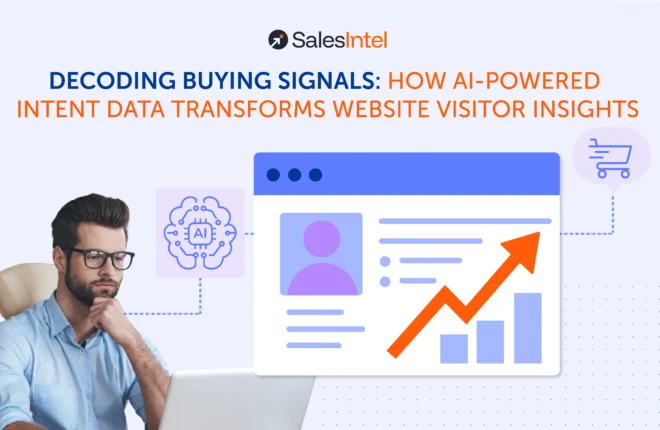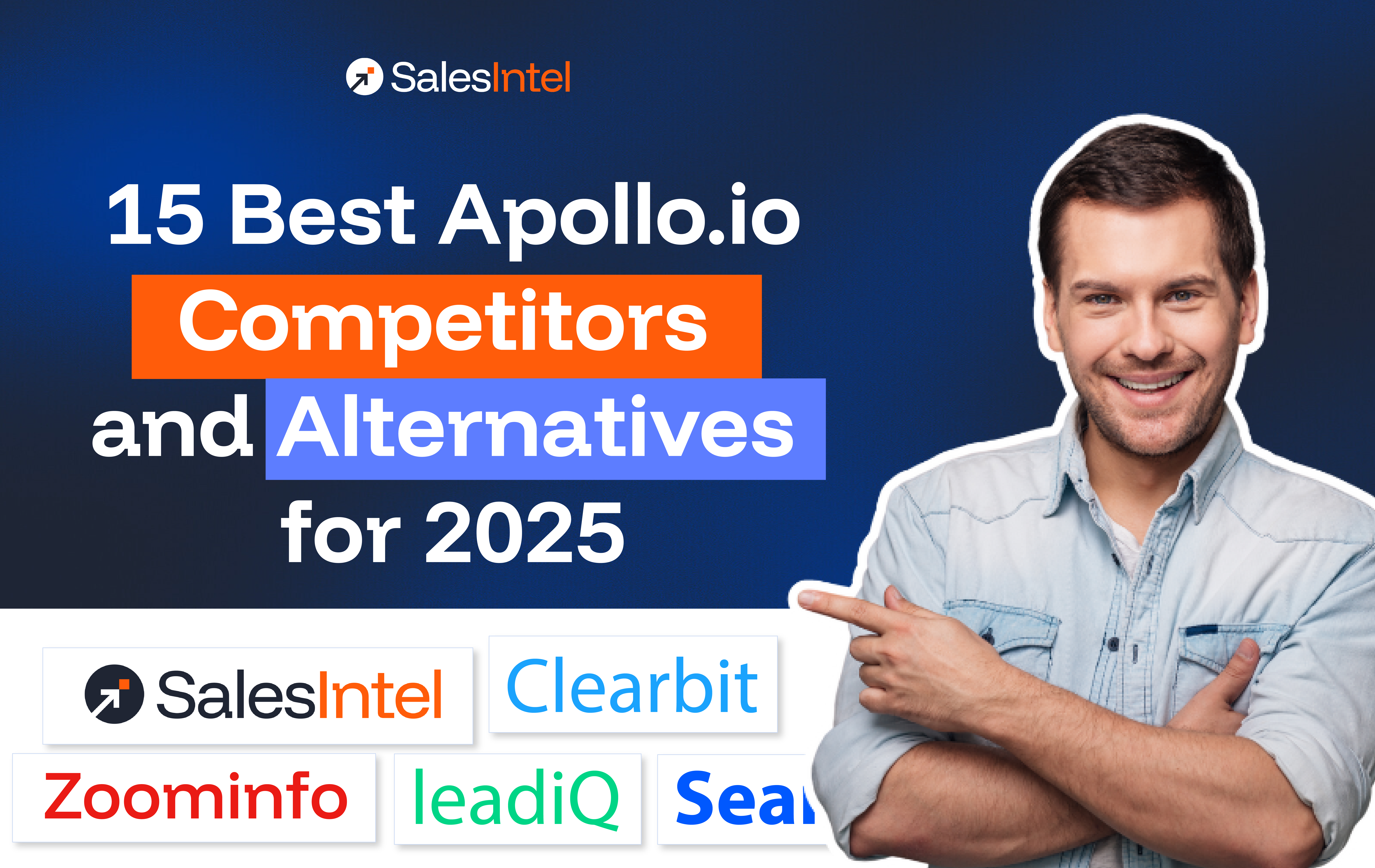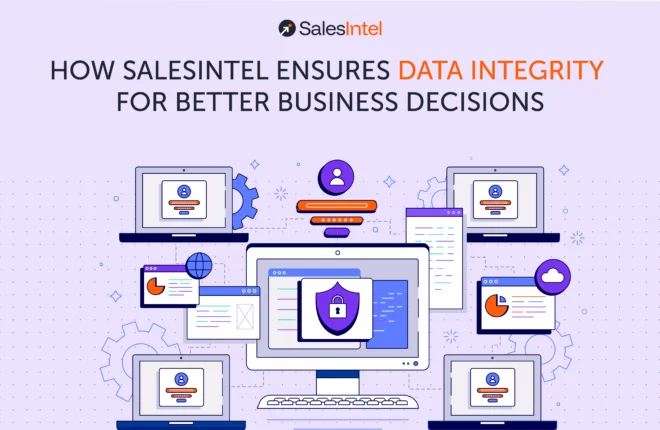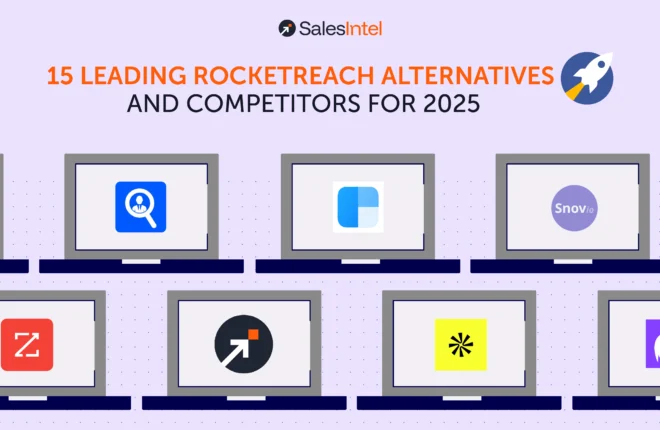Your website attracts visitors, but how many of them are actually considering a purchase? Traditional web analytics tell you how many people land on your site, how long they stay, and which pages they visit. But they leave one critical question unanswered: Are they just browsing, or are they ready to buy?
If you don’t know who is interested, you’re leaving revenue on the table. SalesIntel’s Signal-First Agentic Pipeline Generation Platform fills this gap, not by just identifying visitors, but by revealing where they are in the buying journey and whether they’re serious about making a purchase.
The Difference Between Website Analytics and Buyer Intent
What Traditional Web Analytics Can Tell You
- How many visitors land on your site daily
- Which pages they view and for how long
- Bounce rates and exit pages
These insights are useful, but they paint an incomplete picture. A visitor spending five minutes on your pricing page might be ready to buy or they might just be curious. Traditional analytics can’t tell the difference.
How AI-Powered Intent Data Goes Deeper
Powered by Signal360, SalesIntel monitors thousands of buying signals spanning the entire buying journey . This comprehensive approach solves the fundamental challenge: you need pipeline now AND pipeline for the future.
Predictive Signals (Future Pipeline):
Tracks business event signals like funding rounds, leadership changes, team expansions, and technology adoptions that reveal accounts entering conditions for a buying cycle weeks or months from now.
Demand-Capture Signals (Immediate Pipeline):
Identifies active evaluation signals such as repeat website visits, pricing page views, competitor searches, and content consumption, exposing accounts actively evaluating solutions today. Buying Group Mapping: Identifies company-level engagement and automatically maps the complete buying group, ensuring you engage all key stakeholders.
Why This Matters: Website visits alone don’t indicate purchase intent. But when combined with Signal-First intelligence, businesses can distinguish between casual browsers and serious buyers without waiting for a form fill.
Identifying the Right Buying Signals (Not Just More Data)
Every website visitor leaves behind digital breadcrumbs. The challenge isn’t collecting data, it’s figuring out which signals actually matter.
Key Buying Signals That Signal360 Detects
Signal360 monitors 30+ signal categories, including:
- Business Event Signals: Funding rounds, capital raises, leadership changes, and team expansion.
- Technology Intelligence: New technology adoptions, vendor replacements, and stack changes.
- Engagement Signals: Website visitors, content downloads, competitor mentions, and pricing page visits.
- Champions on the Move: Tracks when your champions or target buyers change jobs, revealing expansion opportunities.
The Shift: From Data Overload to Coordinated Revenue Action
Instead of drowning in raw website analytics, SalesIntel refines visitor behavior and market triggers into a list of high-priority, ICP-fit accounts. The result? Less guesswork, more targeted engagement via our Capture, Qualify, Activate methodology.
The Power of Signal-First Intelligence in Decoding Website Visitors
Tracking visitor behavior manually is impossible at scale. SalesIntel changes the game by identifying hidden patterns and predicting which accounts are most likely to convert.
How SalesIntel’s Capture, Qualify, Activate Methodology Works
Our proprietary methodology transforms scattered market signals into coordinated revenue action.
- Capture: Detect Buying Triggers Before Your Competitors
Signal360 monitors thousands of signals across both predictive and demand-capture timelines. By capturing signals others miss, you detect buying intent earlier and more completely. - Qualify: Focus on ICP Accounts and Map Buying Groups
We validate that accounts with buying signals meet your Ideal Customer Profile (ICP) criteria to surface the accounts that matter most. We then map the buying group, identifying all stakeholders involved in the purchase decision. - Activate: Launch Orchestrated Multi-Channel Campaigns
Our activation layer enables GTM teams to orchestrate relevant campaigns to the right people, with the right message, at the right time. Predictive signals trigger awareness campaigns, while demand-capture signals launch immediate, high-intensity engagement across email, social, and ads.
Matching Anonymous Website Visitors with Company Data
Most website visitors remain unidentified unless they willingly hand over their details. But let’s be honest, very few people fill out forms unless they are at the final stage of buying. This creates a major blind spot for businesses.
AI tools like VisitorIntel fill this gap by de-anonymizing website traffic. They match a visitor’s digital fingerprint such as IP addresses and behavioral signals with firmographic data to uncover the company behind the visit. In other words, you don’t just see that someone is visiting. You see who they are, which company they work for, and whether they fit your target audience.
This means that instead of staring at traffic reports and wondering which visitors matter, your sales team gets a live feed of high-intent companies already engaging with your content. No more shooting in the dark.
Enriching Visitor Insights with Firmographic and Technographic Data
Knowing that a company visited your site is a good start. But not all companies are created equal. Is it a fast-growing tech startup looking for a new solution? Or a student writing a research paper?
AI takes this further by enriching visitor data with firmographic and technographic insights. You don’t just learn the company’s name, you gain a detailed view of its size, industry, revenue, growth stage, and even its tech stack.
If a mid-market SaaS company browsing your pricing page is already using a competing product, that’s a strong signal they’re evaluating alternatives. But if it’s a local bakery with no tech budget, your sales team can skip the call. Signal-First Intelligence ensures you spend time on leads that actually fit your Ideal Customer Profile (ICP) and not just anyone who stumbles onto your site.
Using Predictive Analytics to Rank Accounts by Likelihood to Buy
Having a long list of companies visiting your website is great—until your sales team has no idea where to start. Should they reach out to the enterprise software firm that checked out your blog once? Or the mid-sized manufacturing company that visited your case study page five times this week?
This is where AI-driven predictive analytics comes into play. Instead of treating all website visitors equally, AI assigns a lead score based on behavioral patterns, intent signals, and external market triggers.
It looks at factors like:
Engagement depth: Did they just skim a blog post, or did they download a whitepaper, check out your pricing page, and return multiple times?
Buying signals: Are they actively researching competitors? Have they recently secured funding? Are they expanding their team in relevant roles?
Comparison with past conversions: How similar is their behavior to past visitors who turned into customers?
The result? Your sales team gets a ranked list of website visitors, starting with those most likely to convert. No more wasting time on window shoppers.
Outcome: Turning Website Visitors into Revenue (Not Just Traffic)
Marketing teams spend thousands, sometimes millions, on driving website traffic. But if those visitors remain anonymous and unqualified, all that effort amounts to little more than a high bounce rate.
By leveraging the Capture, Qualify, and Activate methodology, SalesIntel ensures that your sales team focuses on the right accounts.
Instead of cold calling random prospects, they reach out to decision-makers from companies already showing interest. Instead of guessing intent, they reference specific behaviors, like multiple visits to the pricing page.
The result? Higher conversion rates, shorter sales cycles, and marketing dollars spent where they actually matter.
It’s not just about knowing who’s visiting your site—it’s about knowing who’s ready to buy.
Turning Website Visitor Insights into Revenue
Most B2B websites have a major flaw: They only track leads who fill out a form.
That means countless high-intent visitors come and go without ever making it into a CRM. AI-powered intent data changes that by making it possible to engage potential buyers before they raise their hand.
Traditional Approach vs. AI-Driven Approach
| Traditional Approach | AI-Driven Approach |
| Only engages leads after form fills | Identifies potential buyers across both predictive and demand-capture timelines |
| No visibility into anonymous visitors | Matches visitors to companies in real time |
| Sales reaches out without behavioral context | Sales reaches out with insights on specific signals and complete buying group visibility |
Example Scenario: Signal-First Activation in Action
A cybersecurity company notices repeated visits from multiple employees at a Fortune 500 firm.
- SalesIntel’s Signal360 reveals they’ve also been researching security compliance changes and competitors (“Demand-Capture Signal”).
- SalesIntel’s Buying Group Mapping identifies the CIO, CISO, and VP of IT.
- Instead of waiting for them to download an eBook, sales reaches out with a personalized message, referencing their specific concerns via a ProspectConnect sequence.
- The company engages, leading to a high-value deal that might have otherwise been lost.
The Competitive Advantage of Intent-Driven Visitor Insights
AI-powered intent data doesn’t just improve lead generation—it transforms how businesses engage prospects, optimize campaigns, and drive revenue.
Key Benefits
- Faster Sales Cycles
Engage prospects before competitors do by identifying interest early.
2. Better Personalization
Tailor messaging based on what prospects are actually researching.
3. Higher ROI on Marketing Spend
Focus ad dollars and outreach efforts on accounts with real buying intent.
4. Alignment Between Sales and Marketing
Marketing identifies high-intent leads, and sales reaches out with context—reducing friction and increasing conversion rates.
Real world example:
INKY’s SDR team conducted a trial, testing SalesIntel’s platform by exporting and validating over 1,000 MSP contacts. The results spoke for themselves:
- 94% email accuracy rate, ensuring that outreach efforts were not wasted on incorrect or outdated contacts.
- Reliable direct-dial numbers, allowing SDRs to connect with prospects faster.
- Intent data insights, helping the team prioritize MSPs already interested in email security solutions.
Conclusion: From Website Visitors to Qualified Pipeline
Your website already attracts high-value prospects. The problem is, most of them leave without a trace.
Traditional analytics show what visitors do, but not why they’re there. SalesIntel’s Signal-First Platform closes this gap, helping businesses Capture, Qualify, and Activate engagement with high-intent accounts before they reach out to competitors.
If your team is still waiting for form fills to drive sales, it’s time for a new approach. Signal-First Intelligence turns anonymous website visitors into real business opportunities—so you can stop guessing and start closing deals.
Want to see it in action? Schedule a demo to learn how Signal-First Pipeline Generation can fuel your pipeline.
FAQs
What are buying signals and how can they be identified?
Buying signals are actions or behaviors, explicit or implicit, that indicate interest in your solution. Explicit signals include questions about pricing or timelines, while implicit signals include repeat website visits, content downloads, or webinar attendance. Platforms like SalesIntel’s Signal360 make it easier to spot and interpret these signals in real time.
What is the difference between weak and strong buying signals?
Strong buying signals are direct actions such as requesting pricing, proposals, or implementation details (clear indicators the prospect is late-stage). Weak signals, like browsing your website or downloading content, reflect early-stage curiosity and require nurturing. SalesIntel helps teams distinguish both to prioritize accounts effectively.
What is the distinction between Buyer Intent and Product Category Intent?
Product Category Intent shows a prospect is researching solutions within a broad space (e.g., “CRM tools”). Buyer Intent indicates interest in specific vendors (e.g., “Salesforce alternatives”) and is more actionable. SalesIntel tracks both types, helping teams focus on prospects closer to purchase.
What are considered weak or less reliable buying signals in B2B?
Less reliable signals include casual website browsing, basic email opens, low-intent social engagement, or attending entry-level webinars. These actions show awareness, not readiness. SalesIntel helps filter out this noise so teams focus on higher-value signals.
Are there unconventional or less obvious buying signals to look for?
Yes, subtle cues like prospects asking about integrations, mentioning competitors, browsing technical docs, or showing hiring/funding changes can indicate emerging needs. SalesIntel’s firmographic and technographic insights help surface these less obvious signals.
Does engagement with content (e.g., white papers, webinars) indicate immediate buying intent?
Content engagement shows interest but not immediate intent. It typically reflects early- to mid-stage research. High-value content consumption signals a problem to solve but needs further qualification. SalesIntel helps map this engagement to overall buying readiness.
What specific questions from a prospect indicate advanced interest or readiness to purchase?
Questions about onboarding, pricing tiers, CRM integrations, security reviews, or next steps strongly suggest late-stage intent. These inquiries reflect clear evaluation and timelines.
What AI-powered tools or platforms are available for tracking buying signals?
AI-enabled platforms like SalesIntel, Demandbase, Clearbit, and ZoomInfo track behaviors such as website activity, intent surges, and content engagement. SalesIntel’s Signal360 uses AI + human intelligence to combine intent, firmographics, and technographics for more accurate buying readiness insights.
How should sales teams effectively respond to or utilize buying signals to close more deals?
Act on strong signals immediately with tailored messaging, precise next steps, and relevant content. Weak signals should be nurtured with personalized education. With SalesIntel’s real-time signal alerts and enrichment, teams can prioritize high-intent accounts and accelerate deal cycles efficiently.




